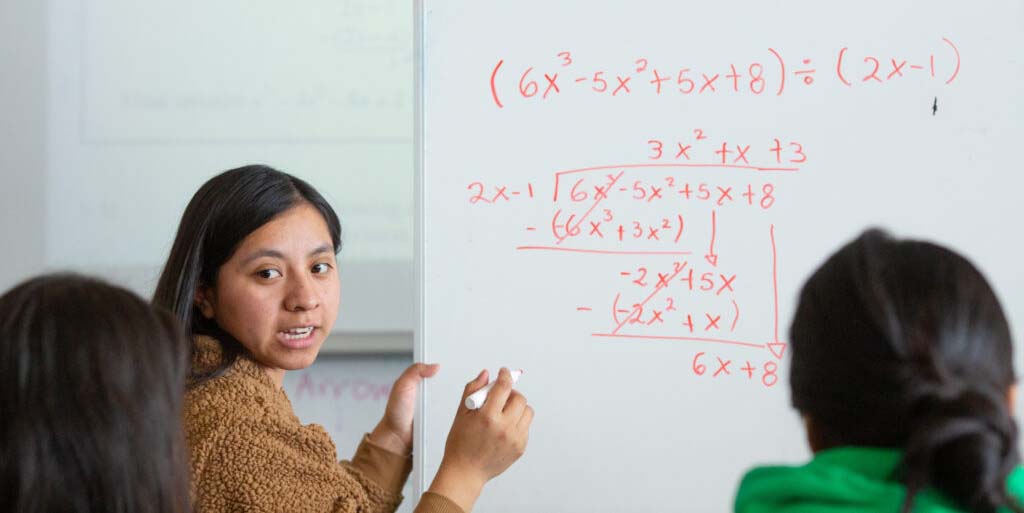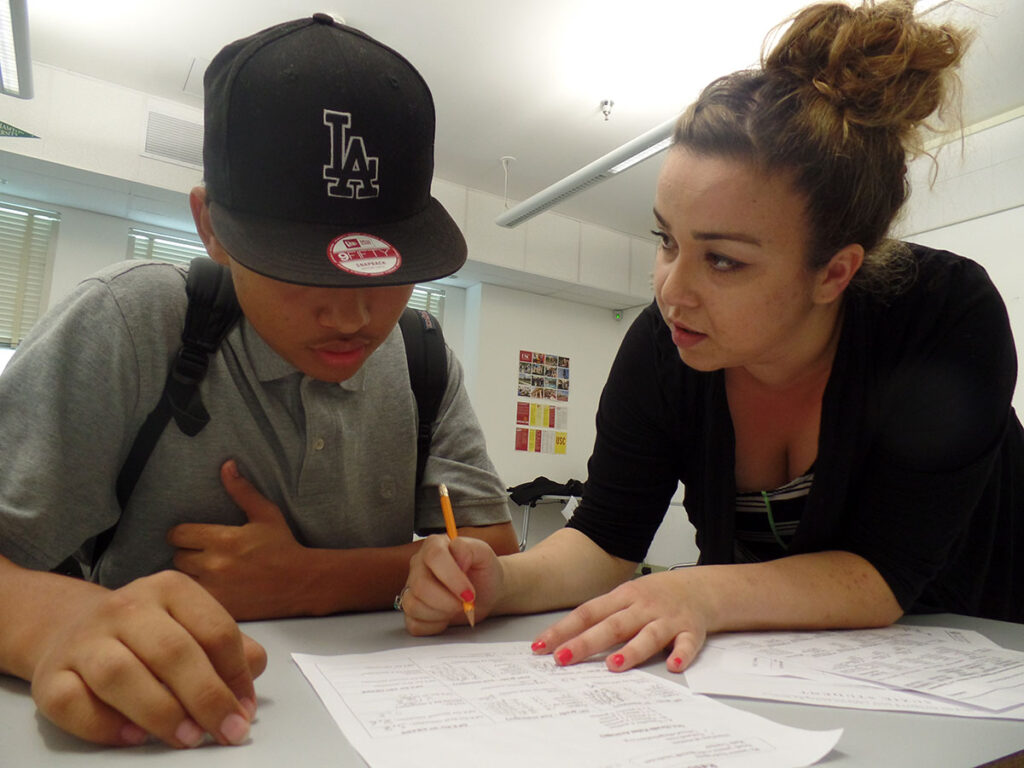A teacher helps a student with a math problem.
Credit: Sarah Tully /EdSource
Deep, active learning of mathematics for all students.
We applaud this goal of California’s new math framework, an increasingly urgent priority in our data-rich, technology-enhanced age. However, the framework is only a guideline. Ensuring that schools and classrooms have the resources — including appropriate policies and high-quality teachers — to achieve the goal entails repairing fractures in our education landscape.
Consider high school graduation requirements, which are literally all over the map:
- Students in San Francisco and Palo Alto complete a minimum of three math courses, including Algebra II. Elsewhere in the Bay Area, East Palo Alto students attending Sequoia Union high schools can finish with just two years of math, and just one year of algebra. So can students in Sacramento.
- Los Angeles has a three-year math requirement and permits Algebra II alternatives for the third year. In nearby Long Beach, all graduates complete four years of math, including Algebra II.
This disarray is possible because California requires just two years of math to graduate from high school. It is one of only three states with such a low requirement. Admission to the state’s public universities, however, requires at least three years of math, preferably four. A majority of districts have set a higher bar that matches or approaches college admission criteria.
But for many California students, the framework’s vision of all students completing three or four years of math remains just that — a vision, not a reality. Too many of them are being left out of the math opportunities that are increasingly important for participating in 21st-century professions and civic life. Research links taking four years of high school math to college access and success. But a quarter of California seniors take no math at all.
The gap in requirements, however, is just one barrier to deep math learning — one that won’t be solved without bridging a second gap, a teacher gap. Doing that demands a commitment from our public universities.

Teaching Mathematics in California
Two decades ago, California State University and University of California teacher preparation programs collectively enrolled more than 38,000 would-be teachers per year. The two systems now produce fewer than 10,000 teachers a year. Teacher preparation enrollments declined by 76% from 2001 to 2014 and have not recovered since.
The Covid-19 pandemic didn’t help keep teachers in math classrooms. In a 2021 national survey of 1,200 school and district leaders, 46% of districts reported shortages of qualified secondary mathematics teachers. In California, nearly half of new math teachers enter the classroom without a credential, according to teacher supply reports.
These shortages fall hardest on poor schools — those serving students with the greatest needs — which have 40% more teachers lacking qualifications than the richest schools do. One of us has witnessed this firsthand as a teacher, coach and professional development leader. In Los Angeles, some schools have few to no permanent mathematics teachers. In one middle school, for example, every math teacher was a long-term substitute. Students had multiple teachers each school year, sometimes for three years in a row. This continual churn of uncertified teachers virtually guarantees that little math will be learned and exerts a devastating impact on students’ preparedness for college,
Confronting the crisis directly means building a teacher pipeline and investing in high-quality, ongoing professional development. A range of strategies would support this goal. They include expanding Golden State teacher fellowships and teacher residences dedicated to science and math teachers. Districts can also consider signing bonuses and retention bonuses for qualified math teachers as well as protection from potential layoffs. Teaching institutes, such as those the state funded in 2001, would also help ensure more and better math instruction.
Instead, the latest contentious debates have focused on narrower issues, often centering on university admission requirements. In 2019, it was CSU’s proposal to add a year of math or quantitative reasoning coursework to admission requirements. It was ultimately shelved.
Then it was the question—raised by an earlier draft of the framework — of middle school math acceleration. Without starting Algebra I in middle school, it is difficult for students to have calculus on their transcripts, which many perceive as a disadvantage in applying to selective universities. However, acceleration policies have traditionally contributed to tracking, in which Black and brown students have been assigned to lower-value math sequences. Vocal San Francisco parents — who objected to San Francisco Unified’s experiment and insisted that students be able to take Algebra I in middle school — are one reason the framework now leaves that decision up to local districts.

UC committee changes admission standard for data science, causing confusion over math framework
A current dispute centers on including options such as statistics and data science — in addition to Algebra II — on the UC system’s list of math courses that fulfill the three-year requirement. After initially supporting expanding options, UC’s admissions board recently reversed itself.
Those are important issues, but the skirmishes detract from more fundamental issues. When students take Algebra I and which math courses they are allowed to take in high school is immaterial if they take only two years of math or if they lack qualified teachers, period. Ultimately, ensuring math opportunity for students means investing in quality teachers. They hold the keys to deeper math learning.
•••
Kyndall Brown is the executive director of the California Math Project, which is mandated to implement California’s math standards with a focus on supporting low-performing schools.
Pamela Burdman is the executive director of Just Equations, a policy institute that works to rethink the role of math in education equity.
The opinions expressed in this commentary represent those of the authors. EdSource welcomes commentaries representing diverse points of view. If you would like to submit a commentary, please review our guidelines and contact us.

